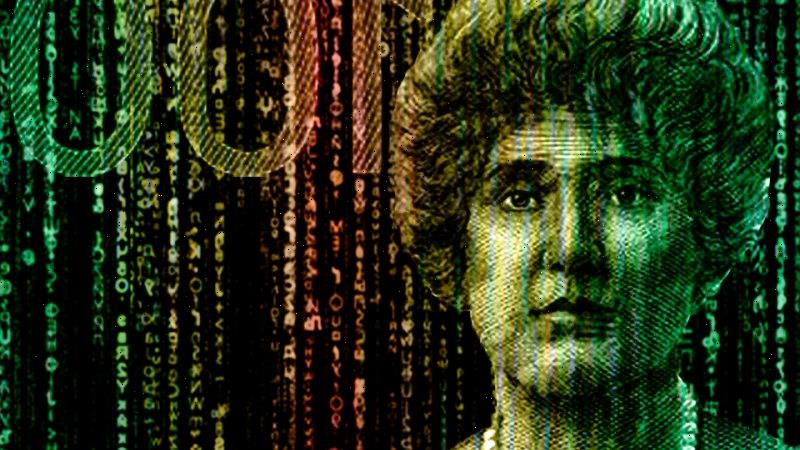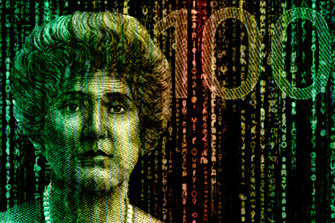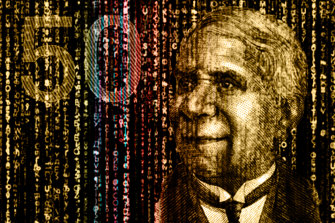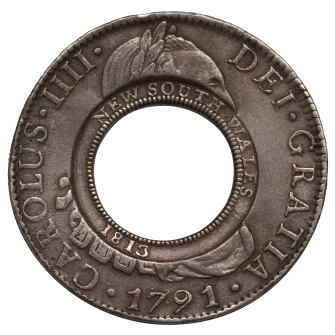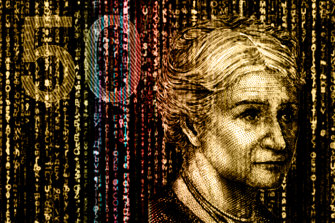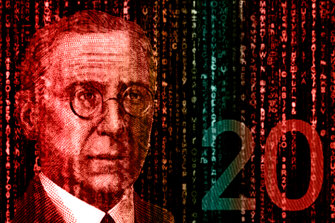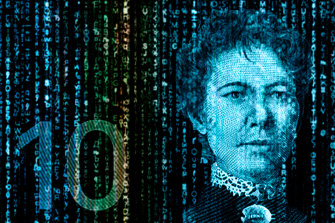Money used to mean cold, hard cash not cards, tokens or digital wallets. Even money’s essence is being challenged. How?
Money – it’s the grease that makes the world turn. It’s a means of exchange. We work for it to satisfy our needs and wants. It is used by some to measure their success in life. We even sing songs about it, how we’d like more and pine for it when it’s gone.
For decades, money has been largely unchanged. Sure, in Australia we’ve moved from paper to polymer notes, ditched the 1¢ and 2¢ pieces, added $1 and $2 coins. Instead of our pay being delivered to us via an envelope stuffed with cash, it is now electronically deposited into our bank account.
Yet starting with the global financial crisis and now the coronavirus pandemic, both money itself and our methods of spending it are changing at perhaps the fastest rate since societies moved from bartering to coin.
There are some people actively investing in alternative forms of money in the belief that what we know as money – backed by a central bank and the government – could change in the near future. More than $US3 trillion has been sunk into cryptocurrencies with advocates claiming that they will replace “traditional” money to pay bills and store value.
Meanwhile, as China tests out a digital yuan, many central banks, including Australia’s, are at least countenancing the idea of introducing digital currencies of their own backed by the government – an “eAUD”.
In an interesting twist – although sightings of $100 notes are akin to close encounters with extraterrestrials – there have never been more $100 and $50 notes in the economy. More cash, not less? How come? And what are to make of all these changes?
Soprano Dame Nellie Melba features on the $100 note.Credit:Artwork by Kathleen Adele based on RBA banknote
What is money?
From seashells to bottles of rum, money has taken many forms over the centuries. We tend to see it as a piece of polymer with a number on the front. Whatever its physical form, money has three key attributes.
It is a medium of exchange, which means people and businesses use it to pay for goods and services.
It is a unit of account. In Australia, we use dollars to work out the value of a good or service or even the size of the economy. From the median price of a house to the price of a watermelon, we measure it in terms of money.
Another ingredient is faith: money doesn’t work without it.
Money is a store of value. A $1 coin, backed by the federal government, is worth one dollar today and tomorrow (unlike cryptocurrencies which can change in value every minute).
Another ingredient is faith: money doesn’t work without it.
“You have to believe the coin or the piece of paper is worth something,” says Professor of finance Raymond Da Silva Rosa at the University of Western Australia.
Every time we use cash to buy a good or service we are expressing trust that the money will be worth what’s printed on the front of the note. Every time we “tap-and-go” a payment, we believe the money is in our account and will be sent to our friendly merchant.
If money is the value we put on the value of goods and services, currency is the medium. So, a house can be worth $1.4 million or 1.4 million cowrie shells (shells were one form of currency used in parts of the world). The dollars and cowrie shells are the currency, the number of those two is the money.
Ngarrindjeri man David Unaipon, inventor, author and campaigner, features on the $50 note. Credit:Artwork by Kathleen Adele based on RBA banknote
How did Australia’s currency evolve?
Australia has enjoyed an exotic money history. In the early days of European colonisation, it was in short supply – between 1788 and 1792, the early settlers at Port Jackson either bartered or used rum (and sometimes English pennies and shillings, Dutch guilders and Indian rupees). In 1792, Spanish coins (Spain’s currency was used through Asia) were shipped to the colony to help. These were used alongside private promissory notes (effectively, IOUs written by one person to another).
By the time Lachlan Macquarie arrived in 1810 to take over as governor, rum had emerged as the main form of payment. The Sydney-to-Liverpool road was paid for with 400 gallons of liquor. The colonial office didn’t seem to have any issues with this and denied Macquarie’s request to set up a bank in 1810. Two years later, the British sent out £10,000 in Spanish dollars. Macquarie asked a convicted forger to knock out the centre of the coins, which became known as dumps and which he valued at 15 pence. The remaining “holey dollar” was worth five shillings.
By 1816, however, it was clear these coins were not enough. Private promissory notes were also the source of growing legal disputes. Macquarie established what would become the Bank of New South Wales. Soon it was issuing “official” promissory notes.
A “holey dollar”.Credit:Royal Australian Mint
The British government formalised currency in its colonies in 1823 by moving to sterling. That, alongside private notes and a variety of Australian coins, would remain the nation’s money until 1910 when the Fisher government approved a national currency. The first true Australian note was produced in 1913.
The dollars and cents used by Australians today started when the country moved to a decimal currency in 1966. Mostly, though, money had a very narrow meaning to most people for decades.
Social worker Edith Cowan was the first woman elected to an Australian parliament.Credit:Artwork by Kathleen Adele based on RBA banknote
How did cash go out of vogue?
What constituted cash started changing for most people with the move by employers to the direct deposit of wages in the late 1980s and early 1990s. Before then, banks ensured they had plenty of staff on during lunch hours as people came in with their work cheque (or welfare recipients with their government cheques) to get them cashed.
ATMs had been around less than a decade at this point and were generally in limited number. Supermarkets were years away from dispensing cash to customers alongside their milk and eggs.
Then as online merchants started to establish themselves in the late 1990s and early 2000s, a new way for people to pay for their online goods came into vogue: PayPal was created in 1998 (and bought by eBay in 2002). Rather than making a bank transfer or using the plastic for a purchase, people could set up a third-party account with PayPal. It proved that money did not have to come from a bank account or from under the mattress.
Meanwhile, micro-purchases of songs and albums by millions of music fans using iTunes (before the advent of streaming services such as Spotify, with their subscriptions) or micro-purchases by players of various online games (the bane of many parents today), highlighted what technology could do in terms of money. Until this point, such tiny purchases were rarely if ever made because of costs such as processing fees. Apple’s iTunes proved this system of small payments through an online portal was financially viable and in demand from consumers.
Until this point, most people understood money as something in a bank account or a cheque account or even accessible funds on a credit card. Any digital transfer of money was for important transactions (such as the weekly wage). Now tech companies were collecting micro-payments and moving them around outside traditional banking networks. The connection that many people had between money and banks had been breached.
Before the pandemic, banks were encouraging customers to use technology such as tap-and-go, either with a traditional EFTPOS (electronic funds transfer at point of sale) card or with an account linked to their smartphones (or their smartwatches).
The pandemic, especially early suggestions that the virus could be transmitted by touching notes and coins, supercharged the move away from cash by consumers. The number of withdrawals from ATMs in the first couple of months of the pandemic halved as consumers either could not buy anything in a shop or used other methods of payment.
Convict Mary Reibey went on to become a businesswoman known for charitable works.Credit:Artwork by Kathleen Adele based on RBA banknote
So, cheques are passé too – and now credit cards?
As new payment methods become attractive, others become less so. At the start of this century, consumers wrote close to 14 million cheques a month. Businesses wrote another 33 million commercial cheques.
Technologies such as direct deposit and electronic funds transfers have eaten into the space of cheques. In October, Australians wrote just 710,000 cheques while businesses wrote 1.5 million.
RBA governor Philip Lowe in early 2021 noted that given the collapse in cheque usage, their days were numbered. “At some point though, collectively, I think it’s in the national interest that we close the cheque system.”
The number of credit cards on issue across Australia fell to its lowest level since the early 2000s in October 2021. For years, Australians were accustomed to lay-by, paying a small amount every week or every month for goods that were then handed over once the bill was cleared. Buy now, pay later operations such as Afterpay and Zip reverse the system. Consumers get the goods upfront and pay off the outstanding amount (which, if you fail to do so, means high missed payment fees) over a relatively short period. Between 2016 and 2019, the number of buy now, pay later transactions went from almost zero to 3.5 million.
Buy now, pay later could become the Betamax of payment systems.
While the growth has been strong, investors in these sectors have started getting out. Share prices across buy now, pay later companies fell 80 per cent over the 12 months to November as doubts grow about their business models. Losses have grown rather than fallen, while customer numbers seem to have plateaued instead of increasing strongly. Regulators in the United States have sought information from both AfterPay and Zip (and three other companies) due to concerns about “accumulating debt, regulatory arbitrage, and data harvesting” across the buy now, pay later sector.
If the US Consumer Financial Protection Bureau ticks off the sector, it could arrest the slide in share prices. An adverse finding could make its life even more difficult.
Just as the VHS killed off Betamax (before being overtaken by DVDs then by Blu-Rays and now by streaming services), not every new technological breakthrough survives despite early hype. Buy now, pay later could become the Betamax of payment systems.
Presbyterian minister John Flynn founded what became the Royal Flying Doctor Service. Credit:Artwork by Kathleen Adele based on RBA banknote
Why is there a record amount of cash in the economy then?
In October, for the first time the Reserve Bank reported there is now more than $100 billion in cash, almost all in $50 and $100 notes. During 2020, Australia recorded the third-largest increase in cash growth among rich nations. Only Israel and Canada experienced bigger increases.
While many people think of cash as a way to buy something, for others it is a form of security.
In the two months after the start of the global financial crisis in 2008, for instance, the number of $50 notes across Australia jumped by 11 per cent. Banks reported people lining up at ATMs or in front of tellers to withdraw their cash. Similar hoarding was seen in the early 1980s recession and in the dotcom downturn of 2000-01.
Between March and November last year, with the Australian economy shutdown, there was a 21 per cent jump in $50 notes and a 13 per cent lift in $100 notes. Not only did we want more high-denomination notes, Australians actually reduced the number of damaged notes they returned to commercial banks. The surge is apparent in this graph showing the total value of all of the $100 and $50 banknotes issued in the past 10 years.
“Much of the strong demand for banknotes can be attributed to people’s desire to hold cash for precautionary or store-of-wealth purposes,” RBA researchers found in 2021. “This behaviour is common during periods of significant economic uncertainty and stress, and many other countries saw similar patterns of cash demand.”
It’s not just notes. Last financial year, the Mint sold $82.5 million worth of coins. Most went to banks. That included $2.8 million worth of 5 cent pieces, the largest regular year amount since 2013-14.
“There are elements of society that still get a lot of confidence out of handling cash including coins,” says Royal Australian Mint chief executive Leigh Gordon. “Certainly, new Australians and people on lower incomes, the elderly, prefer cash.”
It costs 5.9¢ to produce the 5¢ piece but the Mint will continue to do so until there is no longer demand for the coins.
Many studies have shown people who have gone through deep economic downturns or those from countries where governments and central banks are distrusted often show more confidence in physical currency than any electronic version.
Despite the sharp rise in demand for coins during the pandemic, Gordon believes coin use will fall, as it has been over time. “Demand for coins has halved since 2015. After the pandemic I certainly think that trend will continue.”
One of the ongoing debates is the role of the humble 5¢ piece. Gordon says it costs 5.9¢ to produce but the Mint will continue to do so until there is no longer demand for the coins. He won’t reveal the costs of producing other coins, though they provide a healthy return to the government with government profit (called seigniorage) worth $45.6 million in 2020-21: two-thirds more than in 2020.
“That’s the difference between the cost of producing those coins and their face value,” he says. “It’s good business if you can get it.”
Writer Dame Mary Gilmore was a social justice advocate. Credit:Artwork by Kathleen Adele based on RBA banknote
What is cryptocurrency and will it replace money?
Bitcoin, what most people consider the first cryptocurrency, emerged in 2009 as the world was still dealing with the global financial crisis.
The broad concept of bitcoin and other cryptocurrencies is the creation of a digital value that is not issued either by a government or central bank. They are heavily dependent on computer algorithms. Users accept them as a means of payment, store them or trade them electronically.
While they use the word “currency” (the medium of money), cryptos do not share two of the three main elements of money.
Real money is a store of value. But in the time you’ve spent reading this, the value of cryptocurrencies could have moved an extraordinary amount.
(Stable coins such as Tether and Facebook’s Diem, are something of an exception. While in the family of cryptocurrencies, they are a bit like a second cousin, with an asset backing them – say, a commodity such as gold or maybe a bank’s deposits – which tends to make their value more stable than cryptocurrencies.)
In early December, after a warning about cryptocurrencies by the head of America’s central bank, the value of Ethereum, BNB, Cardano and XRP fell by 10 per cent in less than 24 hours. Bitcoin fell almost 30 per cent in value over three weeks.
Another reason cryptocurrency fails as money is that it’s not a unit of account. A business may take a bitcoin as payment, but they will convert that to dollars and cents to work out its value (and whether you can buy the good or service you wish to purchase). This is where stable coins fall down as money – you still need to convert your “Tether” or your “Diem” into a dollar to use it.
Bukele announced his grand plan for a “bitcoin city” that would focus on bitcoin mining and supplied energy from a nearby volcano.
In September, the Latin American nation of El Salvador became the first country to announce it would make bitcoin legal tender. Already using US dollars as its money, Salvadorians were told by President Nayib Bukele that a rich world was ahead by adopting bitcoin as part of the new “Chivo” app that would enable payments across the country.
Within days, as polls showed 90 per cent of locals did not want bitcoin or digital wallets, the app was failing almost constantly. Promised $US30 for signing up to Chivo, people did so for the cash and then immediately stopped using it. Street protests erupted and advertising for the app disappeared.
Two months later, still plagued by app problems, Bukele announced his grand plan for a “bitcoin city” that would focus on bitcoin mining and supplied energy from a nearby volcano.
What was that about faith in money?
Professor Da Silva Rosa says through the pandemic, trust in institutions such as governments and the medical community has been pushed to its limits. He says the fact investors are prepared to be paid negative interest on government debt shows an extreme level of trust but it has also fed the fears of those who don’t trust government.
“If the government is printing a lot of money, and there’s $10 trillion worth of bonds with negative yields, that means there’s a lot of trust in government and its money,” he says.
“[But] there’s a class of people who don’t believe in it. And we’re seeing that everywhere, feeding into issues like vaccines.”
The Reserve Bank as well as other central banks have noted that one of the consequences of ultra-low interest rates has been the search by investors for products or services offering much better rates of return. Given this, and a growing suspicion of institutions, it’s no surprise so much money has flowed into cryptocurrencies. A collision between ultra-cheap money and new technologies could, advocates argue, become the building block for a new future without cash in its current form.
Central banks are particularly wary of cryptos.
Central banks are particularly wary of cryptos. Reserve Bank governor Philip Lowe aired his reservations about “cryptoassets” in a speech in November.
Dr Lowe’s concerns extended from the huge swings in value of cryptos to the lack of anything of value supporting them to the huge amounts of energy used to mint new tokens or “coins”. (Electricity powers vast warehouses of computers that verify transactions.)
His speech came a day after Treasurer Josh Frydenberg committed the federal government to what he described as the biggest overhaul of regulation of the payments system in 25 years. The changes, many of which are aimed at giving consumers and investors confidence in everything from digital wallets to bitcoin, will be rolled out over the next 12 months in what the Treasurer says is an effort to put Australia at the leading edge of financial technology.
Poet AB “Banjo” Paterson wrote the ballad Waltzing Matilda and the book The Man From Snowy River.Credit:Artwork by Kathleen Adele based on RBA banknote
So, what’s the future of money?
As part of the overhaul of the payments system outlined by Frydenberg, the RBA itself could offer an electronic central bank digital currency.
Central banks deliver physical money (all those $50 notes sitting under the mattress around the country) and digital money that it moves to commercial banks.
A central bank digital currency would be a new digital form of money that could be used both by ordinary Australians as well as the commercial banking sector.
If this occurred, a consumer who wanted to buy a wallet-full of eAUDs would not have to go through their own commercial bank. They could directly purchase from the Reserve. It would not only reduce time and costs for major investors but also put pressure on commercial banks to improve their offerings to customers.
Philip Lowe used an address on the future of the payments system to note that there did not appear to be a strong policy case for an eAUD – yet.
“It is possible, however, that the public policy case could emerge quite quickly as technology evolves and consumer preferences change. It is also possible that these tokens could offer a lower-cost solution for some types of payments than provided by the existing technologies,” he said.
One of the reasons for the demise of the cheque, for instance, is the costs associated with its processing. Physical cash is costly to produce and move around between banks and customers. Technology, such as that embedded in digital wallets, promises direct transfer of money at virtually no cost.
The Bank of Finland estimates cash in that country could disappear from general use by the end of this decade.
Changes in payment methods are most advanced across the Nordic countries. The Bank of Finland estimates cash in that country could disappear from general use by the end of this decade. As in Australia, there has been a surge in demand for notes but, again, people are hoarding not using them.
In the case of Finland and its Nordic partners, some of the cash is flowing out of the country to other parts of Europe. Some of it is being stored away by locals, worried what might happen if the technology underpinning tap-and-go cards and digital wallets suddenly stops working. On the other side of the Atlantic in the United States, cash in circulation increased almost a third under the watch of president Donald Trump amid all the turmoil of his four years in office.
Commercial banks, facing an inquiry from the federal government into why regional and suburban bank branches are disappearing, point to the dramatic fall in cash usage (and the surge in online banking).
This country’s payment system took 160 years to move from rum to the Australian dollar. It could take just a few more before we are paying for a rum at the local pub with an eAUD from our digital wallet.
Fascinating answers to perplexing questions delivered to your inbox every week. Sign up to get our new Explainer newsletter here.
If you'd like some expert background on an issue or a news event, drop us a line at [email protected] or [email protected]. Read more explainers here.
Most Viewed in Politics
Source: Read Full Article
